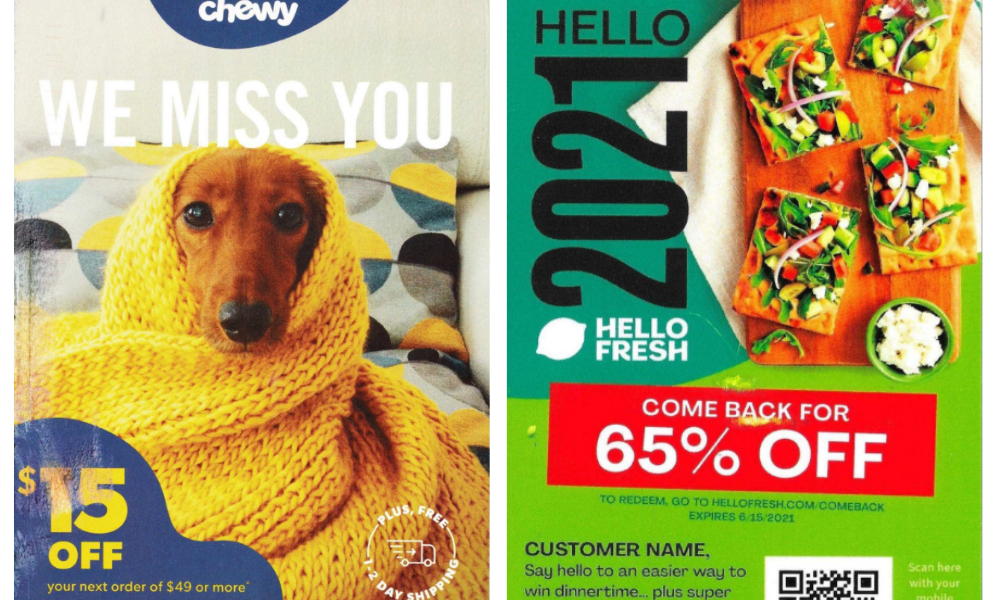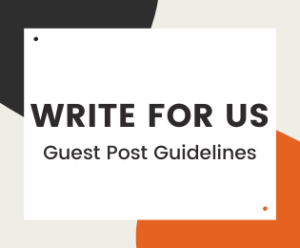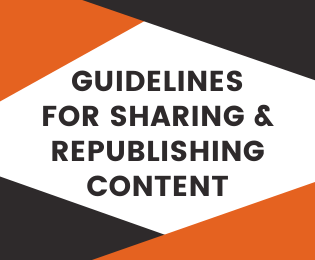INDUSTRY INSIGHTS
Retail Direct Mail: Data-Driven Insights and Trends
Let’s look at what’s changed in several key physical and marketing aspects to guide your retail direct mail in the years ahead.
Who’s Mailing What! collects direct mail in many categories and subcategories, but none are bigger than the retail industry. Over the years, although some marketing activity has shifted to the web with e-commerce and email, direct mail continues to be an essential communications channel for merchants of all kinds. And it’s also changed a lot over the years in this category.
We’ve conducted an analysis of how direct mail has changed in retail during the last 20 years, based on the mail we’ve received. Despite a change in our ownership in recent years — and some differences in our procedures for how we handle mail — there are several trends that became apparent in our assessment of retail mail.
In this article, we’ll look at what’s changed in several key physical and marketing aspects, as well as offer takeaways and recommendations for marketers to help guide your retail direct mail in the years ahead.
Trends and Changes in Retail Mail
1. Distribution of Mail Types
The chart below shows a big shift from 2000 to 2020 in 3 important direct mail formats: envelopes, postcards, and folded self-mailers in our retail subcategories. Envelopes made up 41% of all retail mail from 2000 to 2005, declined to 8% in 2006 to 2010, and have recovered somewhat to make up 20% in 2016-2020.
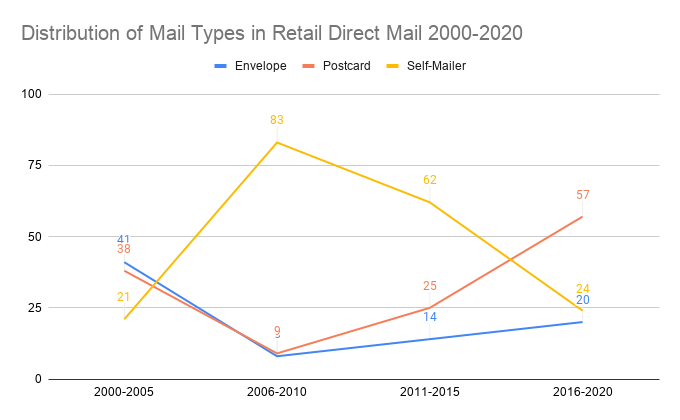
Self-mailers were 21% of retail mail from 2000 to 2005 but shot up to 83% over the period from 2006 to 2010. They then declined afterwards to 24% from 2016 to 2020.
Postcards, meanwhile, aside from the significant drop when self-mailers rose sharply, have recovered lost ground and now make up more than half — 57% — of all retail mail.
Over the past 20 years, many costs associated with direct mail campaigns have increased. Think about the higher prices for paper and other materials, as well as postage, of course. This placed a burden on more expensive traditional formats like envelopes. At the same time, advances in printing technology and the entry of more vendors in the printing marketplace made postcards a more economical option. As we’ll see in later sections, other factors also contributed to this shift.
2. Length of Mail Pieces
For the length of retail mailings we collected from 2000 to 2020, we looked at two important measures: number of pages and word count. We did this to assess the complexity of pieces over that time.
Let’s consider word count changes first.
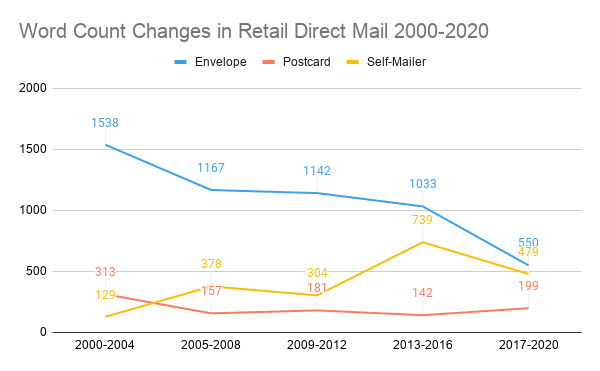
- For envelopes in retail, the average word count declined from 1142 words from 2000 to 2004, to just 550 over 2017 to 2020. This is the biggest decline among all formats, as shown in the chart above.
- Self-mailers rose from 129 words in 2000-2004 to 739 in 2013 to 2016 before moving down to 479 words in 2017-2020.
- Postcards, having only 2 sides for copy, have remained the most stable of the 3 formats; word counts have declined from 313 words at the start of the century to an average of 199 words in 2017-2020.
Now let’s look at page counts with the chart below. When mail is included in Who’s Mailing What!, each side of a sheet of paper (or panel, or envelope side) counts as one page.

Obviously, postcards have seen no changes because they always have only two sides. However, self-mailers have become a bit more complex over 20 years, going from 3 pages in 2000-2004 to 4 pages in 2017-2020.
Envelopes, however, have experienced a decline in complexity. They averaged 8 pages in 2000-2004, but from 2017 to 2020, only 5 pages.
So what does all of this mean? Overall, mail has become less complex in the retail sector with fewer pages and less copy. In some subcategories, letters and inserts have become less lengthy (and less used), with more graphics and images to “show, don’t tell”.
The same preference for short copy goes for postcards and self-mailers, which rely on a “less is more” approach in the AIDA model or sales funnel.
3. Offer Description Length
Who’s Mailing What! provides a description of the product or service offer for each mail piece cataloged. Under previous ownership, a shorter description was preferred, as this chart shows.
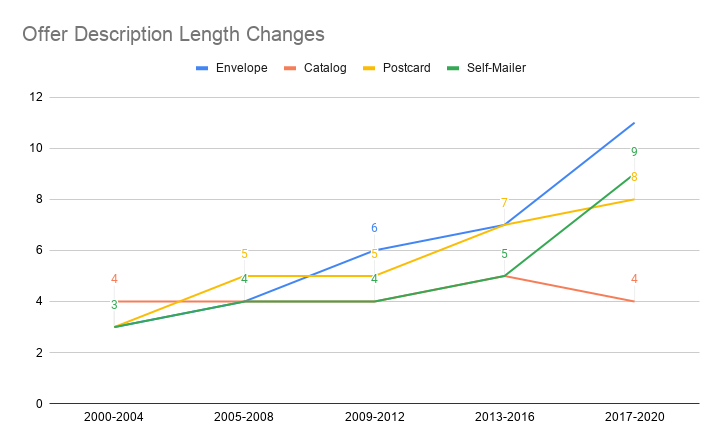
To be candid, we decided to lengthen the description of the offer upon assuming ownership in the past few years. This additional amount of detail in the database helps users understand more about what product or service is being offered, and distinguish those mail pieces from others mailed by the same retailer in that month.
4. Words and Phrases in 2020-2021
Change can happen quickly in any communications channel; it certainly did in 2020, as the COVID-19 forced marketers to adopt new tactics. We looked at the frequency of usage for certain words or phrases in 2020 compared to the entire period of 2015 through 2019.

“Visit our website” appeared in retail mail two times more frequently in 2020-2021 than in the period from 2015 to 2019.
Other popular phrases in 2020 retail mail, such as “no contact delivery” | “contactless delivery” had zero usages in retail mail until 2020 — all because of COVID-19 restrictions.
One more popular word is “QR” which was used in 2% of all retail mail creatives in 2020-2021.
While COVID-19 resulted in these copy additions becoming more common, the technological callouts were growing more popular every year anyway due to changing audience demographics and expectations; COVID-19 just accelerated it.
5. Changes in Discount Strategy
Discounts are an important factor in attracting customers’ attention to a mail piece and enticing them to buy. Our analysis of pricing over the last 20 years produced some interesting insights.
Dollar amount discounts were found to be most common in these retail subcategories from 2000 to 2020:
- Automotive
- Collectibles
- Food & Beverages
- Home & Garden Supplies
- Housewares/Appliances
- Merchandise/Membership Clubs
- Pet Supplies
- Shoes
- Sporting Goods
- Wine & Spirits
Research also revealed that percentage discounts led in:
- Apparel & Fashion
- Arts & Crafts
- Furniture & Accessories
And in some subcategories, neither method dominated:
- Children/Teens
- Consumer Electronics
- Cosmetics
- Eyewear
- Luxury Goods & Jewelry
- Retail — Other

Let’s look next at a major brand in women’s apparel — Talbots — and its experience. For much of the last 20 years, Talbots consistently mailed offers with percentage discounts. Because it is a large and popular brand, it is possible that Who’s Mailing What! just didn’t see a mailpiece with other pricing discounts. Regardless, percentage discounts were all that we tracked from this retailer for birthday, seasonal, friends and family, holiday, and customer appreciation offers.
That is — until 2020.
The company’s strategy shifted to use both types of pricing discounts in its mail. In March 2020, a mailing presented a 20$ off purchase offer. And in October, Talbots mailed a campaign for 50% off the purchase of 3 items. Take a look at a carousel to see Talbot’s mailed ads starting from 2003.
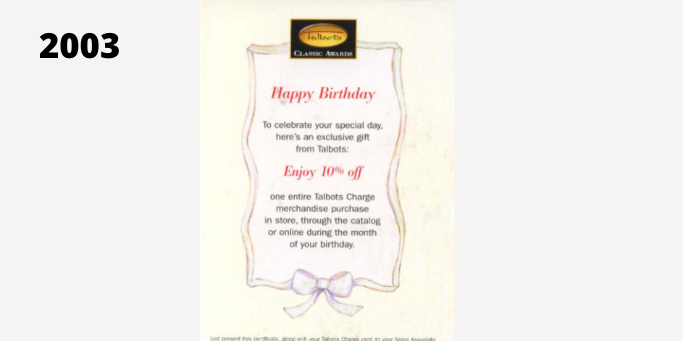
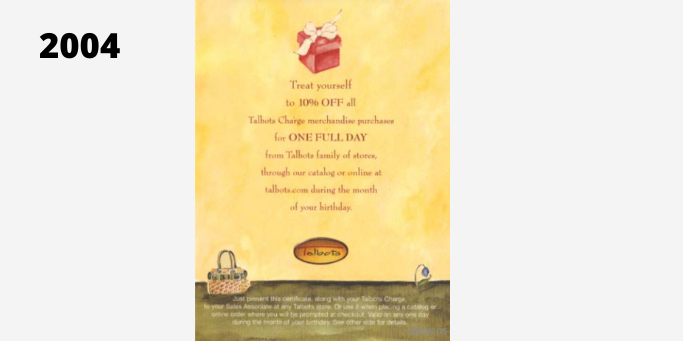
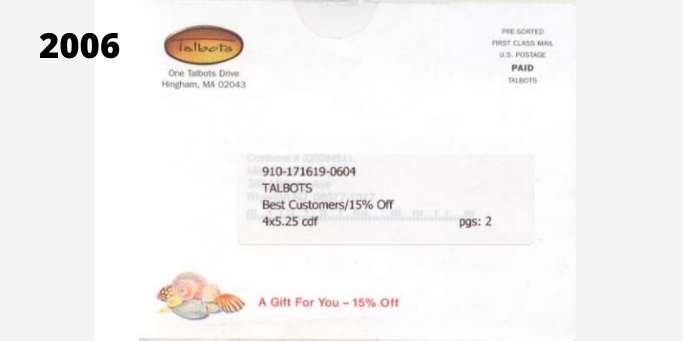
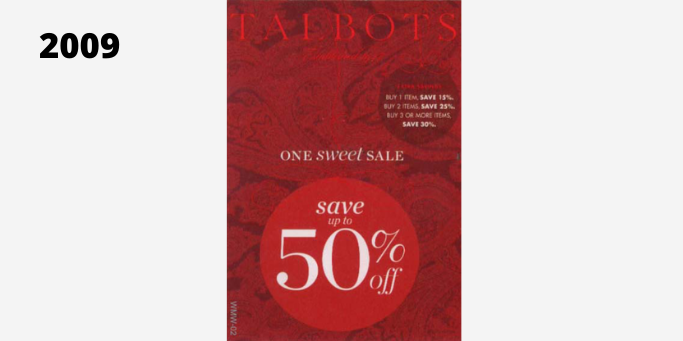


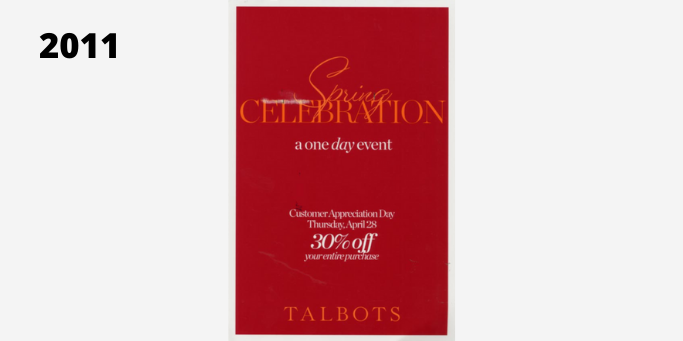







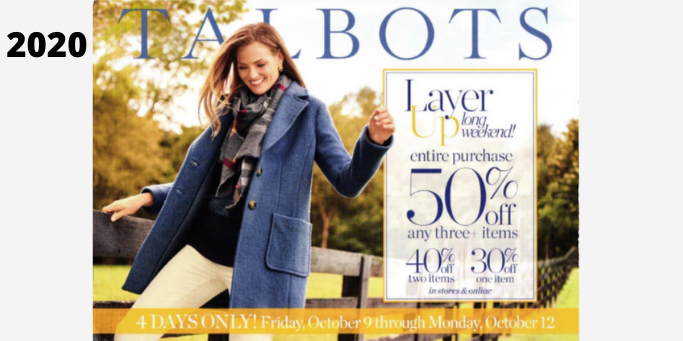
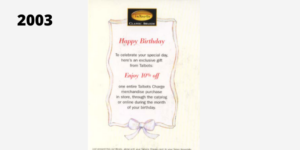
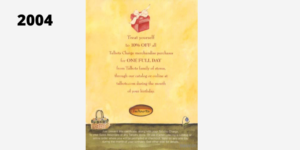
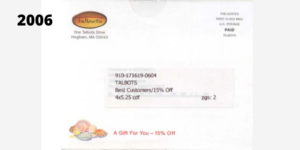
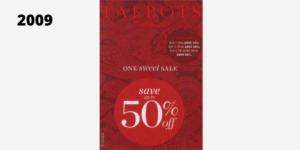
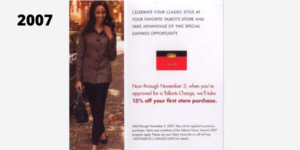
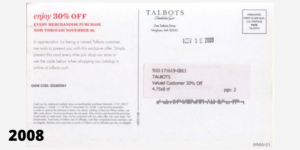
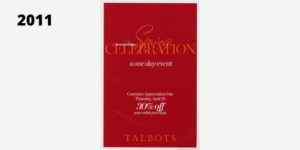
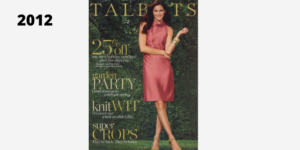
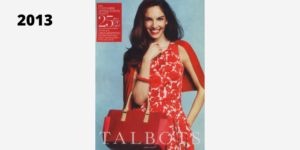

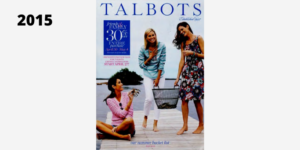


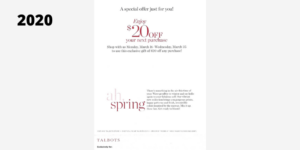

Summary of Trends in Retail Mail from 2000 to 2020
To review, here’s what’s been happening in retail direct mail from 2000 to the present:
- Postcards are now the dominant format in retail mail because they are more economical to print as well as mail.
- Envelopes, though in decline, are still a popular format in some retail subcategories. Depending on the retailer, the offer may be shown on the envelope, or left off, or there may be no copy at all.
- Marketers are using less copy now than ever before in retail direct mail because format use has shifted from envelope mailers and complex self-mailers.
- Dollar amount and percentage discounts are predominant in certain specific industries over the years, though some retailers switch their strategy from one to the other.
- Technological calls-to-action (CTAs) have increased dramatically in just the last year as a response to COVID-19 as well as more customer desire for convenience.
How to Create Top-Performing Retail Mail Pieces
Now that we’ve looked at how the retail industry direct mail has changed since 2000, how can you use these insights in your direct mail efforts?
Based on your findings — and years of experience in observing what works best in retail direct mail — we have some recommendations that will help you create top-performing mail.
Choosing Format and Length
To increase the probability that your message creates an impact, you need to choose the right direct mail format. According to our analysis of Who’s Mailing What! data, the best format to use in retail depends on the subcategory you’re mailing in.
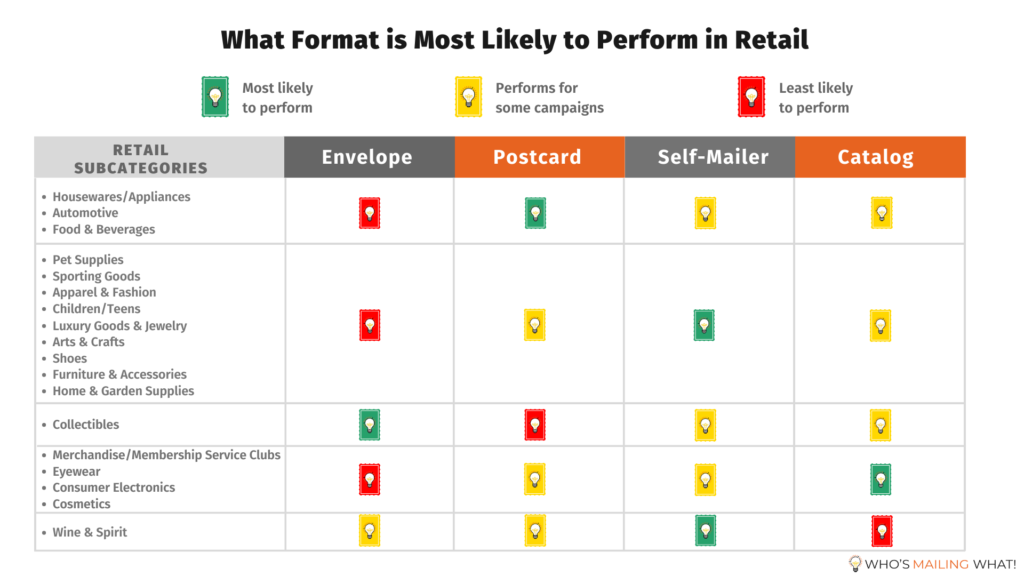
Our statistics show that envelopes are still the best way to mail offers for collectibles, while postcards are the least-used format for this subcategory.
Postcards, on the other hand, are the best format for housewares/appliances, food and beverages, and automotive, according to our database. As we’ve already noted, postcards are simpler now than before. For these subcategories and others, of course, less copy and simpler designs are a better way to attract attention and build interest in consumers.
As for self-mailers, they perform best for pet supplies, sporting goods, home and garden supplies, apparel, children/teens, luxury goods and jewelry, shoes, and furniture.
The length of your mailing is also an important factor in your direct mail planning for the retail sector. Our figures showed that for all three of the formats examined — envelopes, self-mailers, and postcards — the word count decreased over the last twenty years. The page count has also declined.
Consider the advantages for marketers and printers:
- smaller printing costs
- easier format to print
- more economical postage rates
Because there have been clear trends for fewer words and fewer pages, this is an opportunity for copywriters and designers to say more with less. We have a lot of mail in Who’s Mailing What! that shows the evolution of mail in the retail sector, and how you can adapt your mail accordingly.
Choosing an Offer
As we noted earlier in full disclosure, we pull offers directly from each mail piece cataloged in Who’s Mailing What! This is a change from how this data was obtained under previous ownership. Because of different formats as well as most-common practices in different subcategories, it’s difficult to recommend how you should proceed because there are so many variables.
But for now, here are some things to think about:
- Focus your recipient’s eyes on one offer. Two many distractions or multiple offers of equal importance can be overwhelming and confusing. Make it simple.
- Similarly, provide enough offer details so that the customer feels comfortable responding to your offer.
- With the right fonts, point size, and white space (among other design features), position your offer on your mail piece so that it’s easy for the consumer to find, and take action quickly.
Choosing a Pricing Strategy
Many factors go into how products and services are priced and offered at a discount.
Final Thoughts
Retail — even before the COVID-19 pandemic — was one of the most challenging industries in marketing. That’s why it’s so important to study retail direct mail for tips and best practices. Reviewing the 20-year trends in this article will also give you a leg up on your competitors.
Fortunately, Who’s Mailing What! includes direct mail in 18 retail subcategories, so you can see more examples for yourself the evolution of marketing tactics and strategies over that time. You’ll also be able to gather new ideas and develop new inspiration for successful retail direct mail in the future.







